Electromechanical transducer and electrocoustic transducer
a transducer and electromechanical technology, applied in the direction of transducer details, electrical transducers, dynamo-electric machines, etc., can solve the problems of difficult to increase the yield stress of the armature by heat treatment, difficult to use general spring materials with large yield stress and strong shock resistance, and difficult to achieve the effect of improving the degree of freedom in designing the armatur
- Summary
- Abstract
- Description
- Claims
- Application Information
AI Technical Summary
Benefits of technology
Problems solved by technology
Method used
Image
Examples
first embodiment
[0039]An electromechanical transducer of a first embodiment of the present invention will be described with reference to FIGS. 1 to 5. FIG. 1 is a partially cutaway end view (front view) showing an internal structure of the electromechanical transducer of the first embodiment. On the right side of FIG. 1, an X direction and a Z direction are indicated by arrows, respectively. FIG. 2 is a partially cutaway end view (top view) showing the electromechanical transducer of FIG. 1 as viewed from the upper side of the figure along the Z direction, in which the X direction and a Y direction are indicated by arrows, respectively. FIG. 3 is a partially cutaway end view (right side view) showing the electromechanical transducer of FIG. 1 as viewed from the right side of the figure along the X direction, in which the X direction and the Y direction are indicated by arrows, respectively. FIG. 4 is an exploded perspective view of a later-described magnetic circuit portion in the electromechanical...
second embodiment
[0067]Next, an electromechanical transducer of a second embodiment of the present invention will be described with reference to FIGS. 8 and 9. Most of the structure of the electromechanical transducer of the second embodiment is common to that of the first embodiment, and thus different points will be mainly described hereinafter. FIG. 8 is a top view (partially cutaway end view) showing the structure of the electromechanical transducer of the second embodiment, and FIG. 9 is a cross-sectional structural view along an A-A cross section of FIG. 8. FIGS. 8 and 9 correspond to FIGS. 2 and 5 of the first embodiment, respectively, in which the directions represented by X, Y and Z are also common.
[0068]In the electromechanical transducer of the second embodiment, constituent elements that are substantially the same as those in the first embodiment are denoted by the same symbols. Meanwhile, in the electromechanical transducer of the second embodiment, there are provided four yokes 40, 41,...
third embodiment
[0072]Next, an electromechanical transducer of a third embodiment of the present invention will be described with reference to FIGS. 10 to 13. Most of the structure of the electromechanical transducer of the third embodiment is common to that of the first embodiment, and thus different points will be mainly described hereinafter. FIG. 10 is a front view (partially cutaway end view) showing the structure of the electromechanical transducer of the third embodiment, FIG. 11 is a top view (partially cutaway end view) as viewed from the upper side of FIG. 10, FIG. 12 is a right side view (partially cutaway end view) as viewed from the right side of FIG. 10, and FIG. 13 is an exploded perspective view of a magnetic circuit portion in the electromechanical transducer of the third embodiment. FIGS. 10 to 13 correspond to FIGS. 1 to 4 of the first embodiment, respectively, in which the directions represented by X, Y and Z are also common. In addition, a cross-sectional structural view along ...
PUM
 Login to View More
Login to View More Abstract
Description
Claims
Application Information
 Login to View More
Login to View More - R&D
- Intellectual Property
- Life Sciences
- Materials
- Tech Scout
- Unparalleled Data Quality
- Higher Quality Content
- 60% Fewer Hallucinations
Browse by: Latest US Patents, China's latest patents, Technical Efficacy Thesaurus, Application Domain, Technology Topic, Popular Technical Reports.
© 2025 PatSnap. All rights reserved.Legal|Privacy policy|Modern Slavery Act Transparency Statement|Sitemap|About US| Contact US: help@patsnap.com



